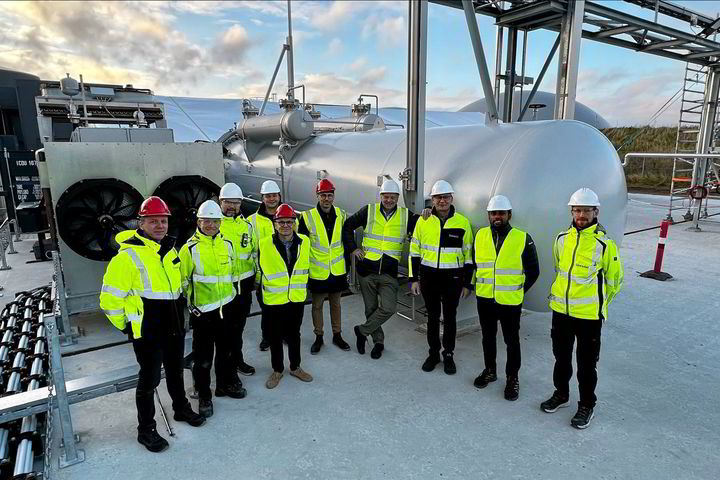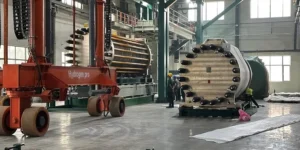INTERVIEW | Green hydrogen breakthrough? Stiesdal’s ultra-low-cost, highly efficient electrolyser begins commercial operation

A new highly efficient, ultra-low-cost 3MW alkaline electrolyser that could significantly reduce the cost of green hydrogen production has begun commercial operation for the first time.
The HydroGen electrolyser, designed by Danish innovation company Stiesdal A/S — led by wind-power pioneer Henrik Stiesdal — has been successfully installed and commissioned at a biogas plant in the town of Glansager, southern Denmark (see panel below for project details).
Not only is it one of the cheaper alkaline electrolysers on the market — Stiesdal A/S maintains its long-term aim of €200/kW when it reaches genuine mass production, around half to a quarter the price of more mainstream technology — it is also one of the most efficient, able to produce 1kg of H2 from only 46-49kWh of electricity (50kWh/kgH2 is generally considered to be a highly efficient system).
The HydroGen electrolyser was designed from scratch to be as low cost as possible.
Innovations include operating at fairly low current density to maximise efficiency, and reducing the flow of electrolyte through to reduce so-called shunt currents that waste electricity, thus improving.
At a more general level, the target is a modular, easy-to-install overall system in which all components are built by experienced third-party manufacturers, thus removing the need to build costly gigawatt-scale manufacturing and develop in-house expertise in multiple areas from scratch.
Article continues below the advert
“Our approach is that we don’t have a big desire to have manufacturing facilities ourselves,” Henrik Stiesdal tells Hydrogen Insight, suggesting that this will reduce manufacturing costs. “We will do assembly of some of the units, but we trust that there are other players who are actually better at doing the mass production than we are.
“When we started doing wind turbines 45 years ago, we bought gearboxes from the leading players, we bought steel shafts from the leading shaft manufacturers, we bought roller bearings from the big players and so on. We did not go out and say, ‘oh, we need roller bearings, then we need to learn how to make roller bearings’ — that would have been crazy — and we are basically doing the same thing here.”
The “trick”, he said, was to select suppliers that are constantly making similar equipment at large-scale, that already have all huge amounts of manufacturing capacity.
For instance, Danish manufacturing giant Danfoss, will produce stacks according to Stiesdal’s specifications — and actually played a major role in designing the electrodes, gaskets and other components. And KK Wind Solutions, the largest supplier of power supply equipment to the wind industry, produce “gigawatts and gigawatts” worth every year.
Another innovation of the Stiesdal electrolysis system is that the electrolyser stacks will be placed inside pressure vessels immersed in pressurised nitrogen.
Henrik explains: “The electrolyser is surrounded by nitrogen gas at the same pressure as the stack itself. There are many benefits from that. The gaskets that we use don’t need to seal against the high pressure on the inside and a low atmospheric pressure on the outside. They only need to seal between the pressure on the inside and the same pressure on the outside, which means that sealing is very easy.
“And we actually maintain a slightly higher pressure on the outside, so if there ever is a leakage, you don’t have gas coming out, you have an inert gas, nitrogen, coming in.
“As far as we can see, it is a very safe arrangement. I think that this idea about having the pressure vessel at a slightly higher surrounding pressure is a really good way to avoid having hydrogen in places where you don’t want it.”
But the use of a pressure vessel also saves significantly on costs. He explains that most electrolyser stacks are cylindrical in order for them to allow large internal pressure, which makes them more energy efficient. But this means that the plates, electrodes and separators need to circular, even though the raw material for these always comes in rectangular sheets on a roll.
“If you need to make it cylindrical, the first thing that you do is you cut away 22% of your [raw] material and throw it away. We don’t need to do that, so we have a better utilization of our raw materials because we don’t have that waste,” Henrik says.
He adds that when electrolysers are expensive, operators want to run it all the time to make the best return on investment. But if the equipment is cheap, “you don’t mind that it’s standing still periodically — you can live with that because your amortisation and interest [on loans] is not really very big”.
This means that connecting electrolysers solely to solar panels, which only operate at an average capacity factor of 18%, or powering them by excess wind or solar power, becomes more commercially viable.
Henrik also says that although alkaline electrolysers have a reputation for not being able to ramp up and down in response to changes in renewable energy output as quickly as other electrolyser technologies, “we just haven’t observed any issues with turning up and down fast”.
It is not just a question of whether such a low-cost green hydrogen production system is doable, he says, “I would rather say we think this is necessary to get to the penetration of clean hydrogen into the energy landscape”.
Henrik Stiesdal is credited with designing the wind turbine as we know it today, back on his parents’ farm in the late 1970s. He also managed the construction of the world’s first offshore wind farm in 1991, and was later chief technology officer at Siemens Wind Power, where he led the design and scaling up of wind turbines from small machines to the multi-megawatt behemoths we see today.
Privately-owned Stiesdal A/S operates four subsidiaries, each focusing on their own green technology.
Steisdal Hydrogen has developed the HydroGen electrolyser; Stiesdal Offshore has developed a low-cost modular floating wind turbine foundation called Tetra, which is now being tested off Norway; Stiesdal Storage is working on a long-duration thermal energy storage system that stores electricity as heat in crushed rocks,; and Stiesdal SkyClean is developing the SkyClean pyrolysis-based carbon capture and storage and green fuels.
Stiesdal A/S’ 3MW HydroGen electrolyser was inaugurated today at a Power-to-X plant in Glansager, southern Denmark, operated by local biogas company Nature Energy and Danish utility Andel.
The facility uses hydrogen in an innovative way — boosting biomethane output from the co-located biogas plant.
Essentially, it is combined with CO2 that is an unavoidable by-product of biogas production, to produce biomethane.
Installation, testing and commissioning took about six weeks, and the electrolyser is now in “automatic, unattended operation”.





